skip to main |
skip to sidebar
The Beginnings. A very nice article at the Metropolitan Library System (you may need to click your "refresh button" – F5 – after clicking the MLS link for the article to open) traces the origins and history of the downtown public libraries before the 2004 opening of the Ronald Norick Library and Learning Center. In a nutshell, the MLS article notes that Philomathea Club (Greek for "love of learning") club was formed at the home of Captain Stiles in October 1889 by the wives of leading city merchants, and the group set out to improve culture and education in the rough and rowdy town born 5-6 months earlier. The group's efforts led to the city's first public library in 1898, initially located in the Farmers National Bank at the southwest corner of Grand (Sheridan) and Robinson. But, with only a room or maybe two, much more was obviously needed. Oklahoma City merchant Thomas P. Mellon (son of financier Andrew Mellon) suggested that the group write his father's associate, Andrew Carnegie, for a $25,000 grant. The article notes that by 1896, Carnegie accepted solicitations for libraries all across the United States and that by 1923 he had helped fund 1,681 libraries in 1,412 towns. Oklahoma City was one of them. In 1900, the cornerstone for Oklahoma City's Carnegie Library was laid at the northwest corner of NW 3rd and Robinson and it opened in 1901.
From My Postcard Collection

From Vanished Splendor (I) by Jim Edwards and Hal Ottaway (Abalache Book Shop Publishing Co. 1982)

Some actual photos of the Carnegie Library are at the Metropolitan Library Website (again, you may have to press your F5 key after clicking the link for the target page to open).
Who could use the library? A December 10, 1905, Oklahoman article reported that, "All residents of the city, or persons having employment therein, are entitled to use the library on signing an obligation to observe the rules and regulations made for the government of the library, which obligation must be signed by one taxpayer who is not a member of the family of the applicant."
Whether that was code-talk for a racially segregated policy, or whether this library was segregated or not, I've not been able to determine. However, consider the text in Jim Edwards, Mitchell Oliphant, and Hal Ottaways', Vanished Splendor III (Abalache Book Shop Publishing Co. 1985), associated with the pic below of the Dunbar Library (the image follows the text):
The Dunbar Branch Library, at 613 Northeast 4th, was opened on July 11, 1926. In the days of segregation, this was Oklahoma City's library for black people. 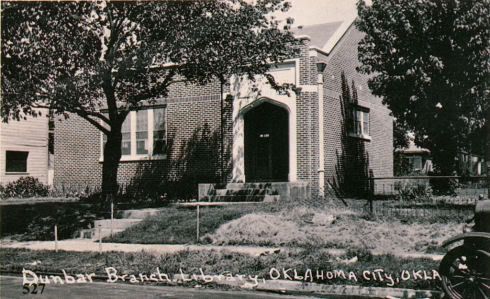
The address on NE 4th places the Dunbar Library at approximately NE 4th & Lincoln Blvd., about 9 blocks from the Carnegie Library.
The Oklahoman's archives reflect that the initial Carnegie facility quickly became too small and that negotiations occurred in 1907 to sell the property to become the home of the Elks Lodge. Instead, another request was made of Mr. Carnegie for $25,000. An April 14, 1907, Oklahoman article reported that Mr. Carnegie would make an additional $25,000 grant to construction a library addition which would double its space. The article said that Dr. J. Hensley, member of the library board, received the notification letter. But, in an August 2, 1907, article, it was reported that, since Mayor Scales did not appoint Dr. Hensley to succeed himself as a member of the library board, Dr. Hensley threatened "to make every effort" to prevent Oklahoma City from securing immediate benefits from the $25,000 gift! Apparently feeling slighted, Dr. Hensley said, "I will block any move the board may make, with an injunction and will then take the matter up with Mr. Carnegie." The article also said, "Work on the library has already been delayed several months on account of the attitude of Dr. Hensley."
Apparently Dr. Hensley was allied with architect and city councilman G.W. VanMeter – VanMeter's plans had been sent to Mr. Carnegie – but with Hensley's non-reappointment, he wrote to Carnegie offering his opinion that the benefactor would be "wise to withdraw the donation." At least, that's the report in the September 5, 1908, Oklahoman, below. The article notes that Van Meter and another had also corresponded with Carnegie's treasurer the result being that even though the $25,000 grant had earlier been made a "hold" had been placed on it but that fact had not been communicated to the city, even though contracts had apparently been let which obligated the city. When Mayor Scales notified the Carnegie organization that the city was about to write a $5,000 draft on the account, he first learned of the "hold" and the article says that, "This came as a thunderbolt to Mayor Scales and the library board."
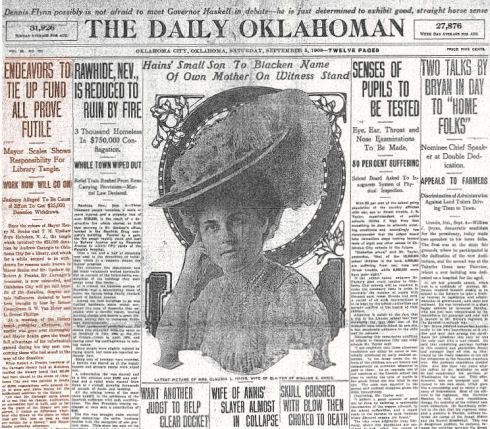
The article reports that Mayor Scales traveled to Hoboken, New Jersey, and in meetings with Carnegie's treasurer, Robert Franks, the nasty correspondence by Hensley, VanMeter, and another, was revealed to him! After meetings, the article says,
"Mr. Franks is a most affable gentleman and gave me a patient hearing, appearing quite anxious to learn all about the affair," said Mayor Scales. "When I had finished he was much chagrined and said that he was surprised to learn that in Oklahoma City, a city of 50,000 people, that there should be such citizens who would put their city in a position so embarrassing," said Mayor Scales. A July 22, 1909, article reported that the expansion had been completed, saying, "The improvements were made possible by the gift of $35,000 from Andrew Carnegie," so it sounds like more was given than was planned in 1907. A June 12, 1910, Oklahoman article said that the library had grown to become one of the largest "in this part of the country, and exceeds any in the state, both in size and in number of volumes."
The Successor Downtown Library. The Metropolitan Library System article notes that, "In 1945, the Friends of the Library association was formed, largely because citizens had become concerned that a library built to serve 10,000 people could not adequately serve 250,000 as it was now expected to do. The Friends quickly pooled public support and were able to secure a $500,000 bond to provide for the construction of a new main library. * * * The new main library was built on the site of the old one and was opened in 1954." In other words, the Carnegie Library was demolished and the new facility was built in the same space.
Larger Image Not Available
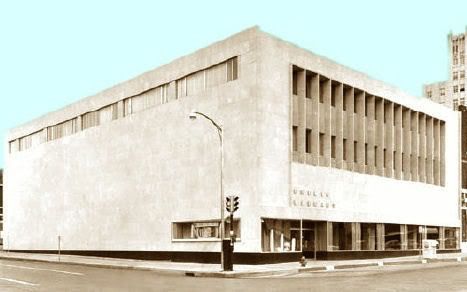
Actually, a July 12, 1953, Oklahoman article shows that the new library was partially opened for business in 1953 with the 1st floor and basement opened, even though it was not formally "dedicated" until Sunday, January 10, 1954. The July 1953 article describes the $600,000 library as "ultra-modern," saying that the new facility was "believed to be the first in the nation to offer drive-up service.
Credit Okc Metropolitan Library System

As it developed over time, in addition to having a parking problem at the busy location, the 1953-54 library would come to be too small, also. Plans were made to build a high-tech facility, perhaps near the Myriad Gardens, but they got nowhere fast. Mayor Andy Coats' 1986 "Six To Fix" proposal included separate specific tax/bond proposals, one of which would have funded a new library, but the library proposal failed.
An April 13, 1988, Oklahoman article speculated about the possibility of having a new library in place by Oklahoma City's 1989 Centennial but described that as a "long shot," as it was since that didn't happen. The new library would have to wait for M.A.P.S.
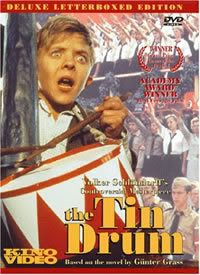 The Tin Drum Affair. During the Downtown Library's tenure at NW 3rd (McGee) and Robinson, one of the city's most embarrassing moments involved what I'll call, "The Tin Drum Affair." A foreboding omen appeared in a November 12, 1980, Oklahoman article which reported that the director of the American Library Association's Office for Intellectual Freedom opined that America's public libraries "are facing a massive new wave of censorship in the wake of last week's conservative election victories." Locally, a February 23, 1966, Oklahoman article reported that the latest "extension" of book banning at Northwest Classen High School by Principal J. Frank Malone included Shakespeare's Romeo and Juliet and Nathaniel Hawthorne's The Scarlet Letter. Already on the banned list was J.D. Salinger's Catcher in the Rye. The article reported an unhappy mom as saying, "Now he's banning Shakespeare ... what's next?" The Tin Drum Affair. During the Downtown Library's tenure at NW 3rd (McGee) and Robinson, one of the city's most embarrassing moments involved what I'll call, "The Tin Drum Affair." A foreboding omen appeared in a November 12, 1980, Oklahoman article which reported that the director of the American Library Association's Office for Intellectual Freedom opined that America's public libraries "are facing a massive new wave of censorship in the wake of last week's conservative election victories." Locally, a February 23, 1966, Oklahoman article reported that the latest "extension" of book banning at Northwest Classen High School by Principal J. Frank Malone included Shakespeare's Romeo and Juliet and Nathaniel Hawthorne's The Scarlet Letter. Already on the banned list was J.D. Salinger's Catcher in the Rye. The article reported an unhappy mom as saying, "Now he's banning Shakespeare ... what's next?"
Fast forward to 1997. In this year, a group calling itself "Oklahomans For Children and Families," a self-appointed anti-pornography group, persuaded all members of the City Council except Mark Schwartz, Ann Simank, and Willa Johnson (to their credit) to support a resolution directed to the Metropolitan Library System, requesting that it reconsider policies to "segregate" certain materials so that only adults could view them or check them out. Included by the group were those intended for children for purposes of sex education. Instead, the director of the Metropolitan Library System, Lee Brawner, opposed the resolution, he preferring a policy that would give parents the option of signing a permission form before a child could get a library card. See Jack Money's March 28, 1997, Oklahoman article for more. The article reports Council member Frosty Peak, the resolution's sponsor, as saying, "This resolution is hardly censorship, or wanting censorship." (Doug Dawgz once-high impressions of Frosty Peak have suffered after reading this article.) More, the OCAF wanted the Library's director, Lee Brawner, and every other member of the library board, to be fired, according to a June 25, 1997, Oklahoman article.
Maybe the above wasn't censorship, but in December 31, 1997, an Oklahoman article reported that Dateline NBC was about to air a segment on what occurred in Oklahoma City during June 1997 and during the months which followed, and in which The Tin Drum Affair would be splashed across TV screens all around the country. Oklahoma City received international scorn, as well.
One of the newscasters at KFOR-TV sometimes says, "Is this a great state, or what?" In this time, the answer would have to be, "or what!" These were dark days for Oklahoma City, in Doug Dawgz opinion. The whole nation and world got to see Okc's dark side, in large part thanks to the OCAF organization.
In June, Oklahoma County District Judge Richard Freeman, at the instance of the "Oklahomans For Children and Families" organization (who had apparently not seen the movie), authorized law enforcement officials to confiscate copies of the award winning movie, The Tin Drum, including the single copy owned by the Metropolitan Library System, and including copies from the homes of citizens who had the movie rented from Blockbuster, et al. The only copy that the Metropolitan Library System had was already checked out by a member of the OCAF organization who, in turn, delivered it to the police, it being the good citizen that the group professed to be.
One who had rented the movie was Michael Camfield ... he was watching the movie in his home when Oklahoma City Police knocked on his door and demanded confiscation of the video. Camfield was a member of the ACLU and that intrusive action didn't set will with him ... as it didn't with many many other Oklahoma Citians. It is good to recall the 1966 mom's query, above, "Now he's banning Shakespeare ... what's next?" Maybe not the "next," but this sad episode will serve to tell the tale.
German author Guenter Grass won the Nobel Prize for his 1959 book in September 1999. The movie version won an Academy Award for Best Foreign Film in 1978. Ensuing Federal Court litigation in Oklahoma City resulted in judgment against then District Attorney Bob Macy and the City which, before all was done, resulted in City liability exceeding $700,000. Federal (and Republican) District Judge Ralph Thompson ruled that the film was not "obscene" and that federal privacy laws had been violated. An October 21, 1998, Oklahoman article said that Thompson's 11 page order said that the decision "was a victory for the Oklahoma County Metropolitan Library System."
The article quoted Lee Brawner as saying that the Library's single copy would be put back into immediate circulation, he adding, "And, we will be ordering many additional copies – with great delight. We will be making available a film to our patrons that they never should have been denied the right to access." The same article quotes Michael Salem, a Norman lawyer who does volunteer work for the ACLU, as saying that he hopes the ruling will restore the First Amendment to Oklahoma County. "This is a case for people who would put fig leaves on Michelangelo's statue of David."
As said above, the liability of the City for judgments and legal fees came to exceed $700,000. In other words, the message to Oklahoma City property taxpayers was, "Pay the bill."
And what was the liability of the self-righteous OCAF? None at all, said its Executive Director Bob Anderson. According to a March 16, 1999, Oklahoman article, he said, "OCAF was merely a messenger to law enforcement authorities, as we have been since 1984." Some messenger!
The OCAF had no responsibility for its actions associated with The Tin Drum Affair. Doug Dawg says, "You guys promote and advocate your policies, as you say as "messengers," but that advocacy which causes city taxpayers to have to foot the bill for your idiotic notions and then you wash your hands of responsibility like Pontius Pilate did ... these guys who are steeped in their Bible background will certainly know what I mean. But, puhleeze ... gimmie a historical Bible break!
Should this group surface again to tell "Oklahoma City what it really needs to know," avoid any such advice as you would a plague of locusts in the "Biblical sense." Either that, or be prepared to pay the bill for what they may persuade you to do, and, then, without any liability for your choice in doing so. They won't help you pay the freight ... only you and other Oklahoma Citians will have that burden.
M.A.P.S. and the New Library. Although Oklahoma City's form of municipal government is not the "strong mayor" model, Oklahoma City surely had a "model strong mayor" in Ronald J. Norick. Doug Dawg is 100% convinced but for his boldness, savvy, cajoling, and persistence – which is to say, his leadership – downtown Oklahoma City and the city, generally, would still be in the malaise it suffered through after the "Oil Bust", Penn Square and other bank closings, and a stalled out and incomplete Pei Plan. By passing the initial Metropolitan Area Planning Projects in December 1993, Oklahoma Citians voted to tax themselves with a penny sales tax for 5 years to accomplish this bold plan, all included on an up or down "yes" or "no" vote (unlike Mayor Coats earlier "Six to Fix" proposal which broke down offerings into single proposals). On December 14 following the affirmative vote, Mayor Norick is reported as saying, "Oklahoma City, welcome to the big leagues." But, unless something happened, the tax would end in December 1998, projects would have to be curtailed or not done at all, and the new library and arena were at risk.
On October 28, 1997, Mayor Norick announced that he would not for re-election. On October 29,the Mayor proposed to put to the people a vote to extend the penny sales tax so that the projects could all be completed. According to the October 30, 1997, Oklahoman in an article by Jack Money and Steve Lackmeyer, the mayor is reported as saying, "I wouldn't mind taking the heat on this. It would be my final hurrah." The City Council would need to be persuaded for that to happen. "Absolutely not!" said Frosty Peak, and the article reports that council member Jack Cornett was "equally hesitant." A November 3 article by Lackmeyer & Money predicted and speculated that Mayor Norick's announcement would make for a "Wild Mayoral Race" and, indeed, it did!
Money and Lackmeyer were at it again in reporting the results of a poll, paid for by Mayor Norick. In their November 6 article, they reported that the poll showed support amongst voters to extend the tax and complete the projects "despite delays and increases in building costs." "Norick said he was most surprised by the response to a question about the proposed tax extension. While he thought it might receive a 30 percent approval rating, the poll showed a tax extension would receive a 50 percent approval with 2 percent undecided." The "two guys" (Lackmeyer & Money) were at it again in reporting council member Guy Liebermann's "first shot" of the mayoral race – in their February 3, 1998, article, they reported that he advocated "shelving" the indoor sports arena (do you remember the Hornets? No arena, no Hornets or our next NBA team in Okc!). In March 2, the prolific writers reported that, "MAPS Solutions Become Focus of City's Mayoral Candidates."
To cut to the quick, Kirk Humphreys who ran on a campaign to "Fix Maps Right," won the race (defeating Lieberman in a runoff), and April 14, he was sworn in as the city's new mayor. But, what would come of the MAPS sales tax extension proposed earlier by Mayor Norick?
On December 8, 1998, a 6 month extension of the sales tax would be put to a vote of the people. A Money/Lackmeyer article in the November 22, 1998, Sunday Oklahoman, opined that "MAPS Showed Way Out of Defeat" and in another article on the same day, they said, "MAPS Restored City's Spirit." Hmmm ... it seems to Doug Dawg that these two Oklahoma City cheerleaders with the power of the pen helped shape Oklahoma City's history! What do you think?
Larger Image Not Available
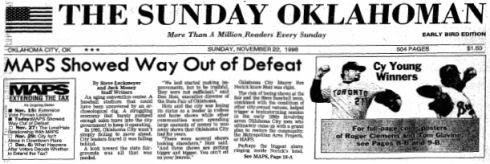
On Wednesday, December 9, the same two guys reported election results on page 1 – 67.67% of voters voted to extend the tax and "Fix Maps Right."
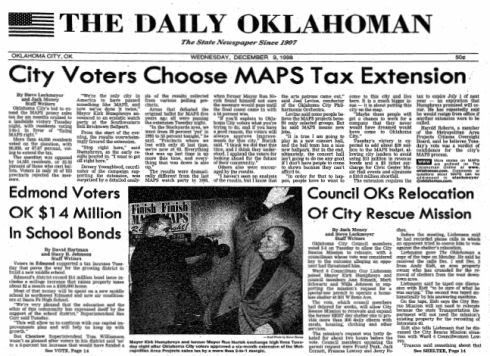
The Ronald J. Norick Library & Learning Center. This magnificent facility is located on Park Avenue between Hudson & Harvey. A December 31, 2003, Oklahoman article announced that, "The City Council had voted to name the new library the "Ronald J. Norick Downtown Library. The vote was followed by a lengthy standing ovation from those in the council chambers." According to the report, "Ward 1 Councilman Mick Cornett brought the proposal before the council to name the library. Cornett said Norick risked his political career on the ambitious plan." Later, in an April 25, 2004, article, Steve Lackmeyer quoted then Mayor Mick Cornett as saying, "MAPS has changed Oklahoma City forever." And, so says Doug Dawg, as well. The new downtown library opened on August 17, 2004.
Larger Image Not Available
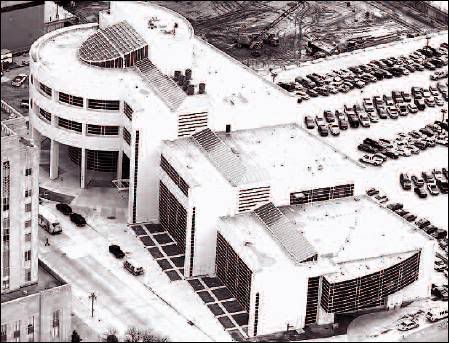
And, with this very long introduction, here are the pics I took on my visit to the downtown Norick Library on Saturday, July 28, 2007, which featured the library's new "First Edition Café." Click any image for a larger view.
Approaching from the West on Park Avenue

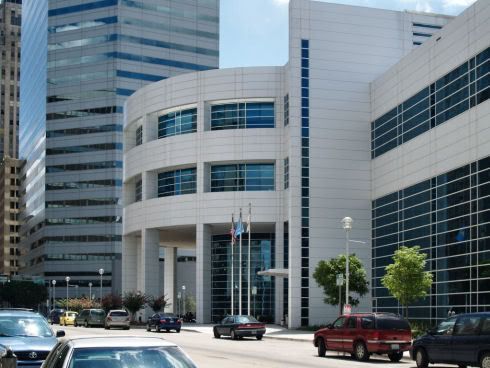
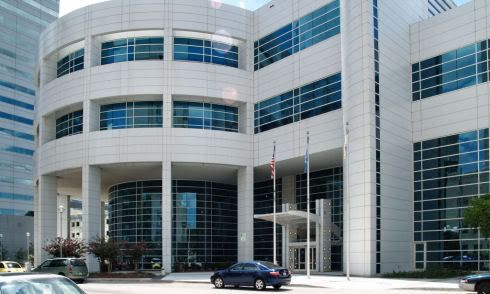
Looking Southwest From Harvey
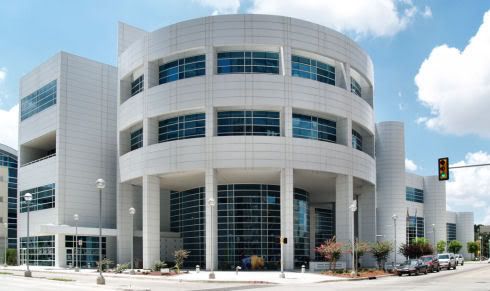
Looking South on Harvey to Central Parking
First Edition Café entrance is on East Side of Library

Bust of Mayor Norick on 1st Floor
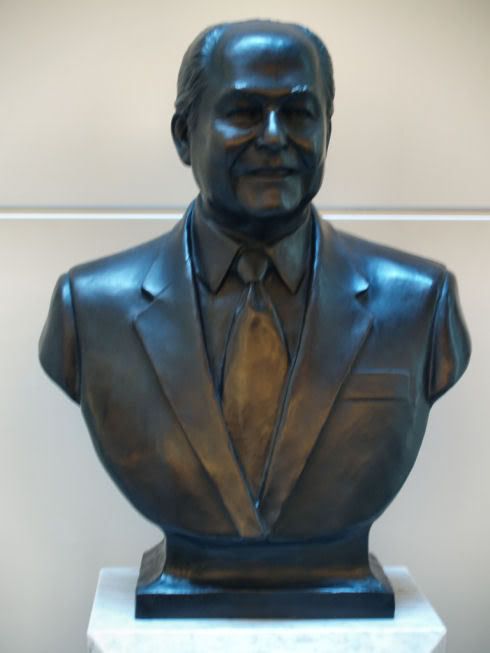
Inside The Café Looking East To Oklahoma Tower

Inside The Café Looking Up and South
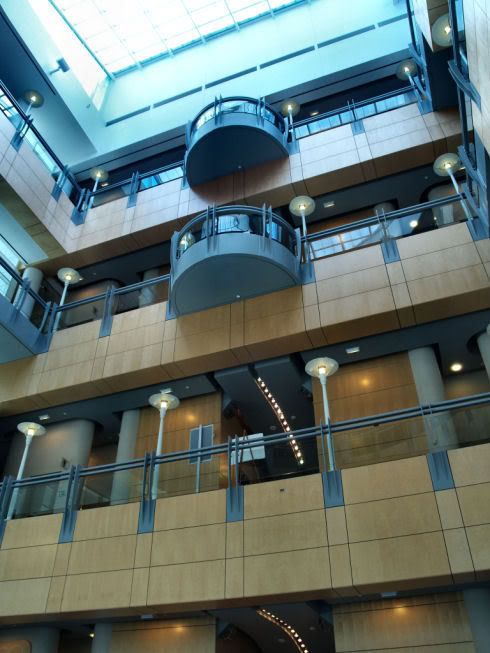
Inside The Café Looking Up and Around
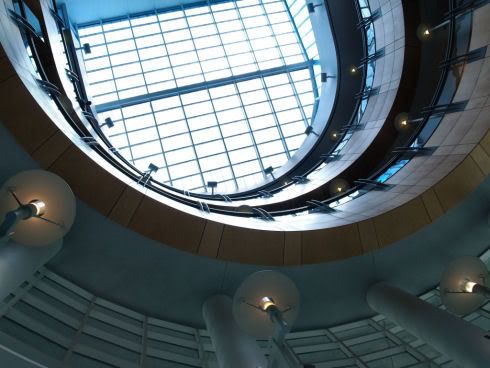
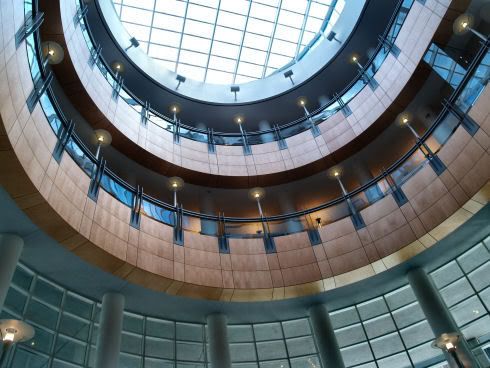

On Fist Floor Looking West
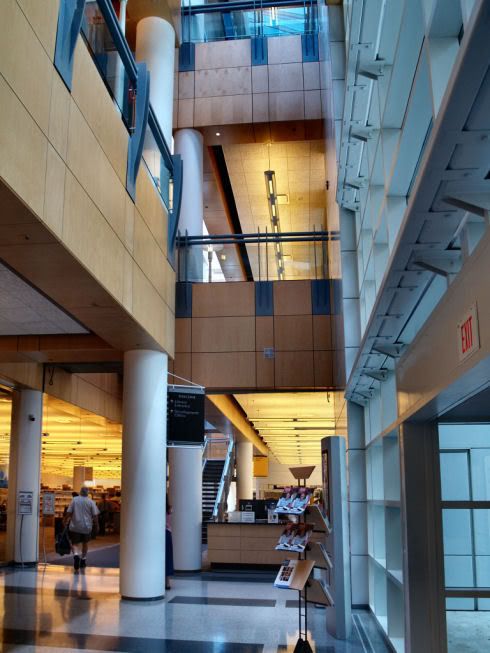
On Second Floor Looking Up
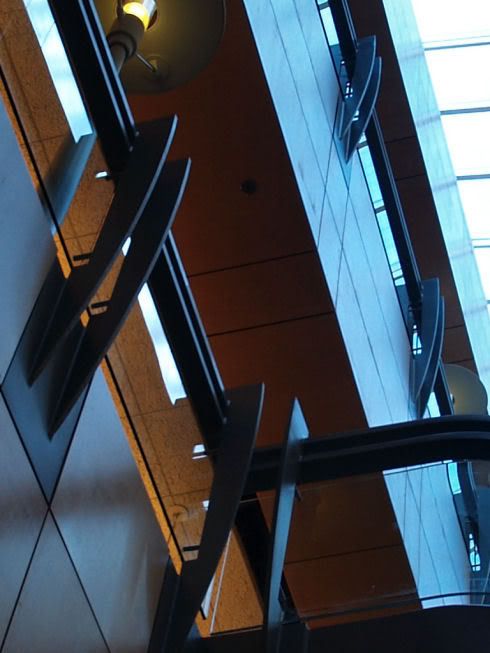
On Second Floor Looking Southwest Into Reading Room
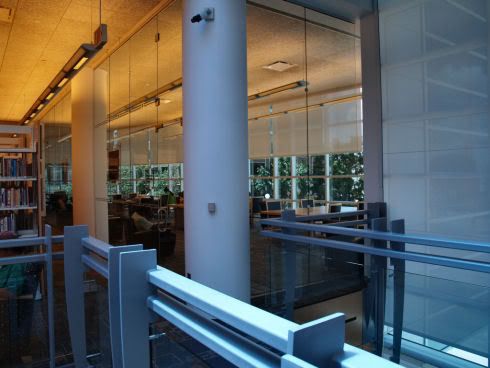
On Second Floor Looking At The Oklahoma Room
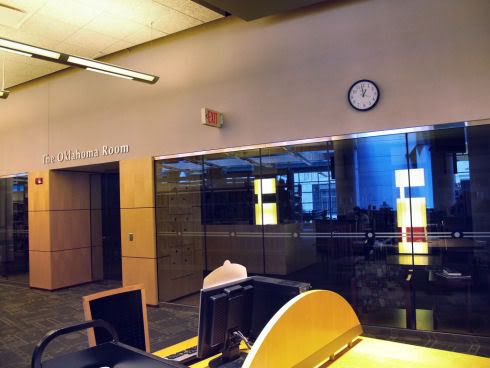

On Fourth Floor Looking West
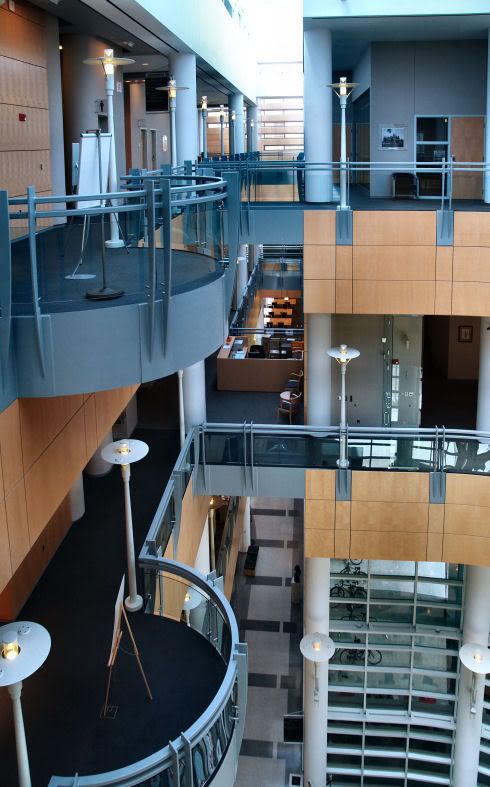
On Fourth Floor Looking Down At The Café
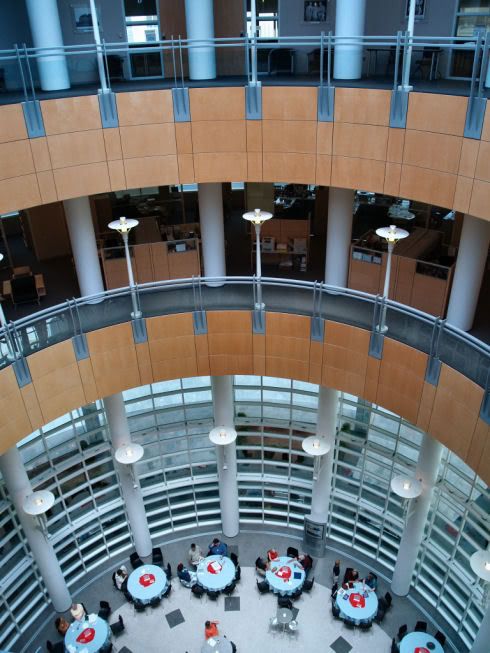
Say ... Who Are Those Guys In The Middle?

Yep. It's The Two Guys Who Helped Shape Okc History,
Steve Lackmeyer & Jack Money!
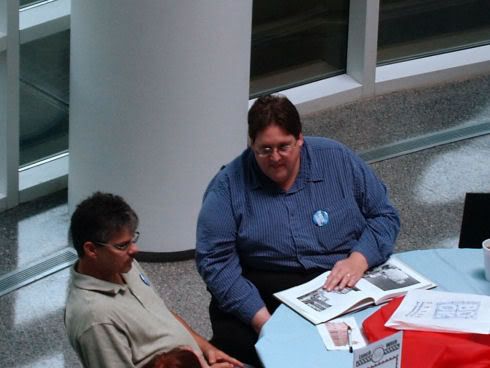
There you have it and now I'm done!
Go To Top
... Click here to read the full article and any comments ...
... is in the works! (Update note 8/29/2009 ... see the new Vintage Map which is developing nicely.)Since OkcHistory.com has "honored" Doug Dawg by linking to my now "stale-dated" clickable "Vintage" map of Downtown Okc (located in my website, not here in my blog ... unfortunately blog limitations make it impossible to place that clickable map here) ... Click on the map to enter the clickable map page

... Steve Lackmeyer & Jack Money (owners of that website) have at the same time "shamed me" (not by their criticism but only by Doug Dawgz self-imposed analysis) into making that "Vintage Map" into more of what it really ought to be!
Soooo ... I've started to remedy that! My goals are (1) use a more accurate map and not just the one that I "drew up" myself (for this, I'm using a 1957 map which shows Okc as it existed before E.K. Gaylord was constructed on the east side of downtown and before Interstate Highways were in place); (2) expand the map's area to cover a much larger region than before (13th on the north, Wheeler Park on the southwest, Klein on the west and Stonewall on the east); and (3) in the expansion, show LOTS more "vintage" buildings and areas of "central-city" than I've shown before.
So, this new project is intended to be much more than simply "Downtown" but will include near-downtown stuff, as well, including all of "Midtown" and "Deep Deuce."
For example, on the west and southwest, Delmar Garden and Wheeler Park will be included ...
 
On the east, the relocated Douglass School (at NE 5th & High) will be; in "Bricktown", historic buildings like the original Douglass Schools will be; on the north the former Colcord Home and other buildings along 13th Street will be; and on the south the (still existing but unused, as such) Union Station will be shown.
Far from being "finished" but only in the works, this project will hopefully be done within 2 weeks' time. When finished, you will be able to "click" on any building identified in the new map and a separate web page will open showing the building and giving a brief description.
For accuracy, the new map is based on a "real" 1957 map I located at Doug Hamilton's booth at Antique Avenue Market. A preview of the new clickable map is shown below:
Click on the image for a full view

Building "color" will indicate its "use," e.g., "aqua" means a public building of some type -- schools, government, transportation, other public. This all may change before the "final" version is done, but you get the idea.
Because the map covers a much larger area than my "old" vintage map, it won't be possible to have readable "descriptive text" on the map but I'll find some other solution ... certainly as you "hover" your mouse over a building, a short description will appear, but I'll try to make something else that will work, also, such as a "list" of buildings or something else more user-friendly.
Sooo ... stay tuned ... this post will be updated as developments occur!
... Click here to read the full article and any comments ...
 On a fine Sunday afternoon (7/22/2007), I ventured to Antique Avenue Market at 5219 N. Western (immediately west of Bishop McGuiness School) to visit Doug Hamilton and his "booth" there. I was looking for some "vintage" maps ... which I got, plus the neat little book described here, as well! 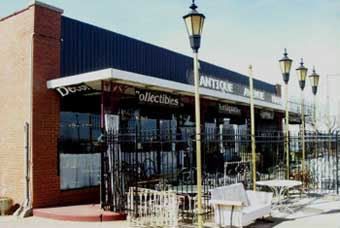 Doug H. is a good friend and an Okc history benefactor of mine (from him, I got my copies of Born Grown, Vanished Spendor, Vols. I, II, III, and And Satan Came Also, among other things (he'll also sell you some fru-fru stuff like Okc vintage matchbooks, Beverly's "finger bowls," etc., if you'll let him!). Not for me! I just want "hard history!" But, if "hard history" is to be found, I'm a sucker! I did find a pair of neat old maps (1913 and 1957 city maps -- they are a work in progress for later Doug Dawgz Blog posts but will soon arrive). Of course, I had to buy a few postcards that I didn't have! But, the small jewell that I picked up from Doug is the book described in this post, The Life of a Successful Bank, 1908-1978, the story of Fidelity Bank, Oklahoma City, and it may have been my best "find" of the day (even if I paid more for the other items I purchased)!
The book isn't large (88 pages including the index) and its paper is not glossy (and so the images could be better), but it does contain information I'd not yet learned from any other source. The book was published in commemoration of the bank's 70th birthday, 1978. Even though the bank has now been absorbed by Tulsa-based Bank of Oklahoma, it is a good thing to remember Fidelity Bank and its contribution to Oklahoma City's legacy.
At the time it was written, its Chairman and Chief Executive Officer was Jack T. Conn ... as in "Father of the Conncourse" which has recentely been renovated and renamed, "The Underground." But, Conn was the guy that got that done in the 1st place.
For Most Images Below, Click On A Pic For A Larger View
Except As Noted, All Are From The Book
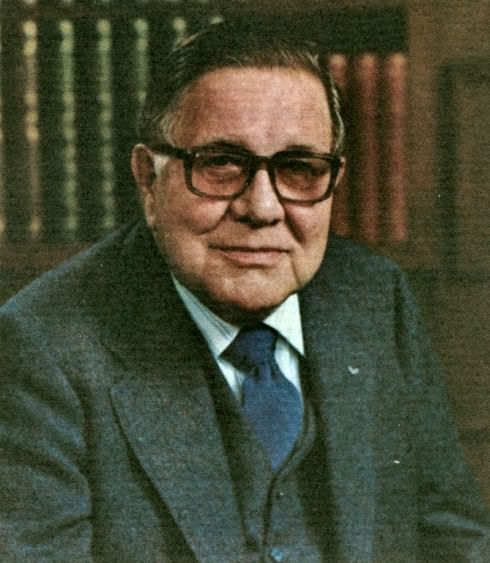
I hadn't realized that "Fidelity Bank" owed its origins to the "First State Bank." The 1st home of "First State Bank" was the "Lee Building" in April 1908 (now called the Oil & Gas Building) at the northeast corner of Main & Robinson. Then, the Lee Building looked like this:

Both Fidelity and Liberty Banks weathered the financial panic of 1907 and survived for quite a long while ... even though 6 Oklahoma City banks failed during 1911-1912. In 1913, new investors moved the First State Bank to the Colcord Building. While there, an interesting anecdotal story in the book reads,
Banking in those days was not solely a matter of high finance. In January of 1916, for example, the direcotors met for an entire afternoon to examine notes carried by the Bank and charged off five notes -- three for ten dollars, one for seven dollars, and one for eight dollars. Later that year the board voted to charge off the remainder of a note after the debtor signed over to the Bank a valuable stallion in part payment. In 1921, the bank went "national" and assumed its new name, "Fidelity Bank." And, in 1923, it also found a new home ... the Baum Building. The image, below, of the Baum Building, is the very best that I've personally seen.
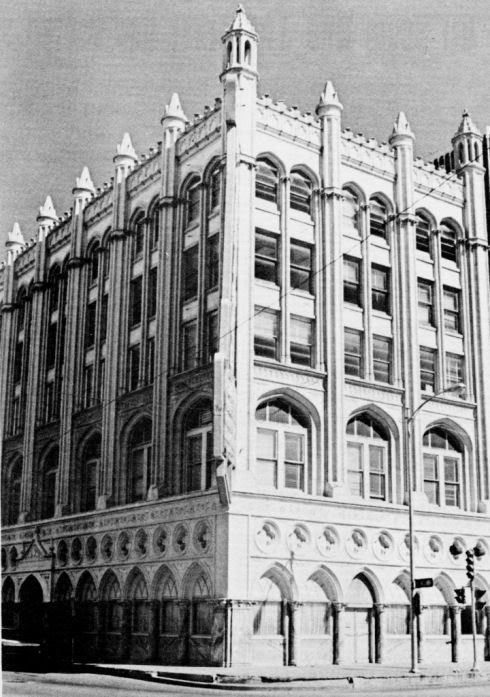
From the Oklahoman's Archives, August 16, 1986
Larger Image Not Available
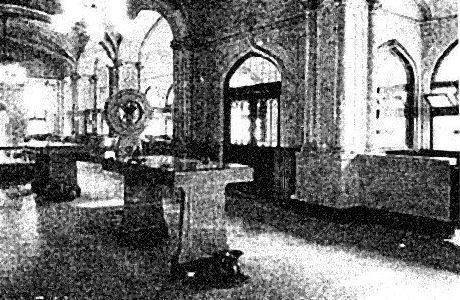
The caption above the August 16, 1986, Oklahoman article reads, "The majestic interior of the banking floor in the Baum Building helped create the popular opinion that the bank had the most beautiful office in downtown Oklahoma City."
As the post-World War II environs of the bank expanded, the gorgeous Baum Building was no longer adequate to handle the bank's needs ... and so it built the 1st "skysraper" in Oklahoma City following World War II, finished in 1957 ...
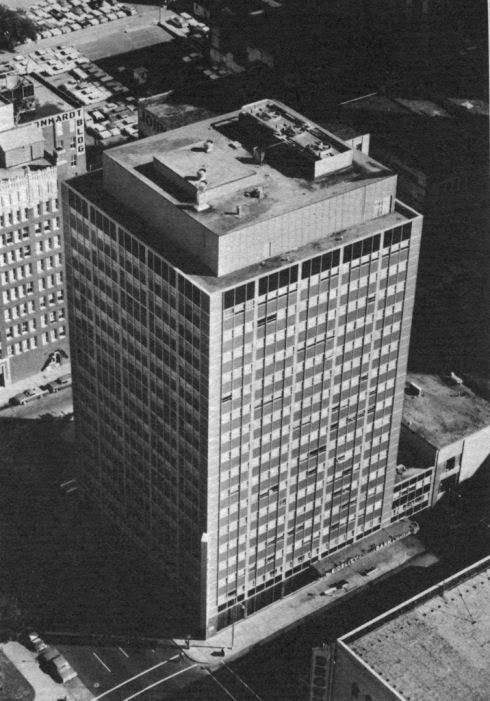
After Fidelity Bank established its new quarters in the newer still building shown in the cover (above, top), its 1957 structure, above, became known as the "Park Harvey Center," which served for many years as an office building before being converted to an apartment building in this day. This building was my office home for more than 12 years.
Mr. Conn was very much into Oklahoma City history ... hence, the tunnel's name "Conncourse." In that subterranean walkway dedicated in 1974, he stuck a little piece of history into it ...
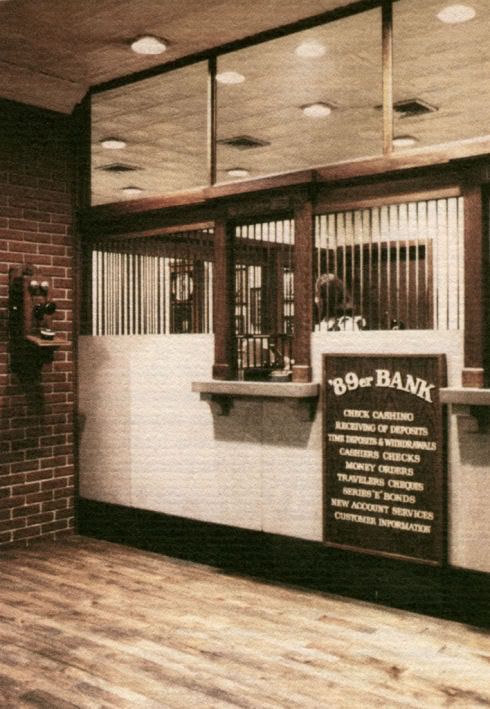
While not failing as many Oklahoma banks did in the "Penn Square Bank/Oil Bust" miseries of the time, the bank did suffer and, with a new multibank law in effect, Fidelity merged with Tulsa based BankOklahoma Corp. In 1983, when the merger offer was initially presented, Bank of Oklahoma was Tulsa's largest bank with assets of $1.5 billion and Fidelity was Okc's 3rd largest bank with assets of $765.8 million. At that time, the Tulsa based bank had already acquired 9 banks in the Tulsa area.
In 1987, the once-fine Whitehall Club which occupied the top 2 stories of the building closed due to dwindling membership. Opening in 1972, a July 9, 1972 Oklahoman article said that it was modeled after a famous English residence of kings and that Jack Conn was the "guiding light" for the project. A June 20, 1987, Oklahoman article notes the auctioning of numerous Whitehall Club items, such as a Louis XIV (14) commode, topped by a gray marble lid. Before the auction, the article quoted the auctioneer as saying that, "This is one of the largest and most elegant restaurant sales we ever made in the state," he noting that about 115 red velvet chairs in excellent conditon were in the offerings.
Not mentioned in the book is the fact that state and federal judges were offered free membership in the club. A December 16, 1981, Oklahoman article titled, "Judges See Nothing Wrong With Free Club Membership," noted that about 20 Oklahoma County and Federal judges received club priveleges without having to pay the $400 enrollment and $25 monthly membership fee. Right! Wrong! The article names names and quotes quotes but I'll not do that here, but what a hoot since the article notes that the bank was a party ligitant in more than 50 county-court casees during the 2 years before the article was written!
I will add one quote from the same article which will do no disredit to the others since I've not mentioned them by name ... and the quote that I will add from the aricle is from a local district court judge that some lawyers came to dislike because of his bad-courtroom-manners ... to lawyers and/or to litigants ... but I haven't ever heard of him being faulted because he was not even-handed about the law or the facts presented to him. That man is Jack R. Parr, District Judge, Oklahoma County, at the time. The article reads,
"I don't accept that sort of thing," Parr said. "Somebody might give me a Cadillac and keys and I wouldn't accept that either. I don't think it's proper for a judge to accept any sort of free gifts or memberships," Parr said. "One thing is just like another." In days long gone, Doug Dawgz got his whippings for doing things I've since forgotten before Judge Parr ... but ... everyone else got them, too. Judge Parr was consistently the same to everyone in his courtroom and so the impoliteness he could present could cut everyone to the quick. But, as to the law, everyone (lawyers, at least) knew that he would read, and apply, the law as it was written to the facts before him decide. I've never heard a criticism about him in that respect, ever.
As regards the issue and the above article, Judge Parr was certainly "in the right," in my opinion.
Of course, the above stuff occurred after this small and perhaps "self-serving" book was written. Still, this little book is quite a charmer, containing more history than I've said here. It's a good find!
... Click here to read the full article and any comments ...
Saints, St. Ann's, St. Anthony's, Saint A's, whatever you want to call it, was established in Oklahoma City in 1898, 9 years after the Land Run. Its first "permanent" home, finished in 1899, is shown below, at 1000 N. Lee, then outside Oklahoma City's limits. Click on the pic for a larger image
Credit Vanished Spendor by Jim Edwards & Hal Ottaway
(Abalache Book Shop Publishing Co. 1982)
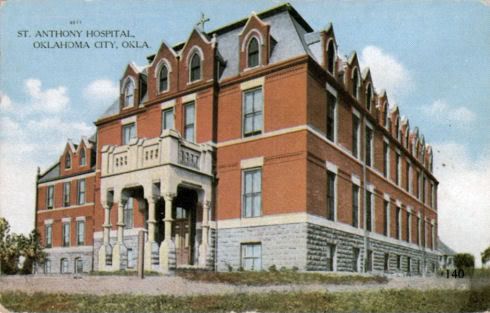 It was Oklahoma City's first "permanent" hospital and was located near downtown in the area called "Midtown" today as is shown in the Oklahoma County Assessor's 2005 aerial view shown below. Plaza Court, Kaisers (Grateful Bean), and the Federal Campus are shown for reference.
Click on the map for a larger image

Modest Beginnings. How did it get started? A pair of Roman Catholic Franciscan nuns (Sisters Beata Vinson and Clara Schaff) traveled to Oklahoma City from Missouri in the spring of 1898. They were looking to raise funds here for a hospital there (in Maryville, Missouri), apparently thinking that 9 years after the Land Run they'ed find some benefactors here, and they sought permission from the local priest, Rev. D.I. Landslots, to solicit funds for that purpose. Whether he gave permission or not I don't know, but, at the least, he requested and charged the Sisters to go back to Maryville and carry a request that the Order to establish a permanent hospital here ... none existed at the time in the city or even in Oklahoma Territory, according to an April 26, 1998, Oklahoman article.
It worked. In July 1898, 4 Sisters returned and rented a pair of houses on NW 4th (one a residence, the other a temporary hospital ... which would later become the location of the Murrah Building ... so the ties between the Order and the later Murrah Building were/are longstanding).
When the initial hospital opened, it had no electricity, sewage, running water (water had to be hauled by the nuns from 4 blocks away) or natural gas. In fact, it had to close in November 1898 because of those problems.
A very nice summary of history is gleaned from the April 28, 1998, Oklahoman article mentioned above ... it commemorated St. Anthony's 100th anniversary. Click the image below for a readable version.
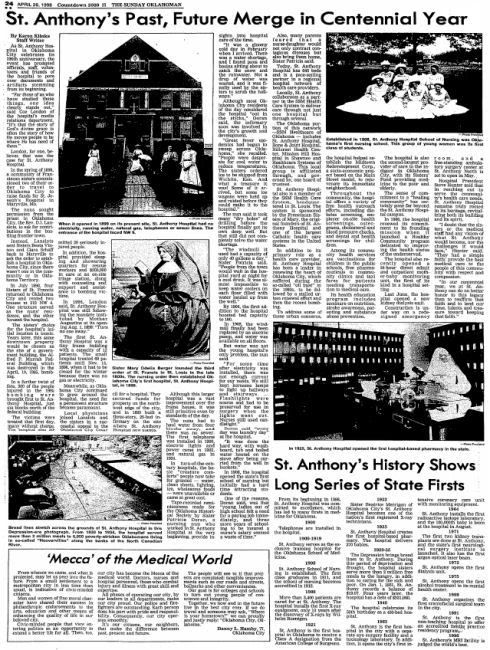
The main article says that phones were installed in 1900, electricity in 1902, and natural gas in 1904, and that the hospital's entrance faced NW 9th.
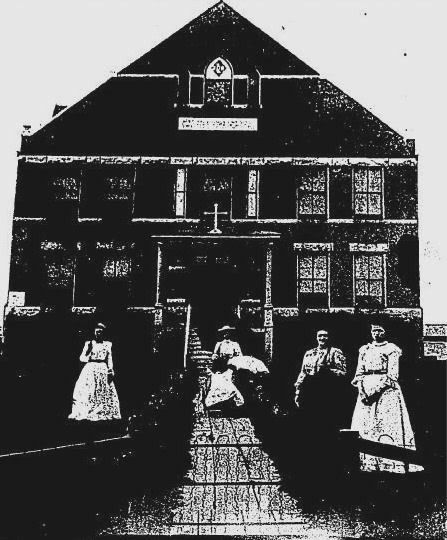
The same article notes that the St. Anthony School of Nursing was established in 1908, the first graduating (1911) class being shown below.
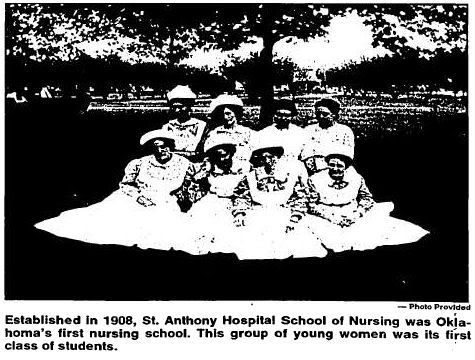
The Sisters had been instructed by their Mother Superior Augustine in her August 1, 1898 mandate, "Turn no one away." In the aftermath of the Murrah Building bombing, much beyond the death of Sister Augustine, 300 of the people injured in the 1995 Murrah bombing were brought to Saint Anthony's, the hospital nearest to the Murrah Building, and many were treated without charge. During the Great Depression, hospital Sisters served more than 2,000,000 free meals to the hungry. The hospital's bank balance was $19.07 on January 1, 1931 ... four years later, it was in debt by $331,060.
But, I digress! St. Ann's continued to grow after its 1899 facility was constructed. Below, images from my postcard collection show what Saint A looked like in the 1940s.
Click on the Images Below For A Larger Image
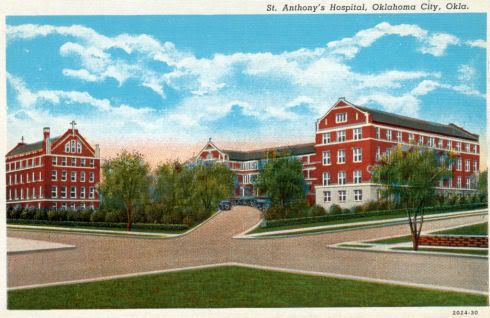
The card below bears a 1946 postmark
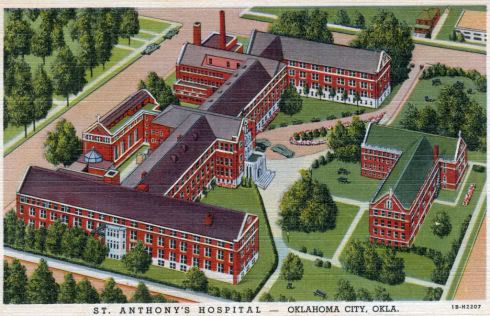
The above is Doug Dawgz hospital of birth in 1943! Hooahh! (Sorry ... had to do that.)
The Competition. Although St. Anthony's was the first, other hospitals came to occupy what we now consider "close-in" space. Some are shown below.
Click on the pics below for a larger image
Credit Vanished Spendor by Jim Edwards & Hal Ottaway
(Abalache Book Shop Publishing Co. 1982)
Rolater Hospital, 325 NE 4th, circa early 1900s
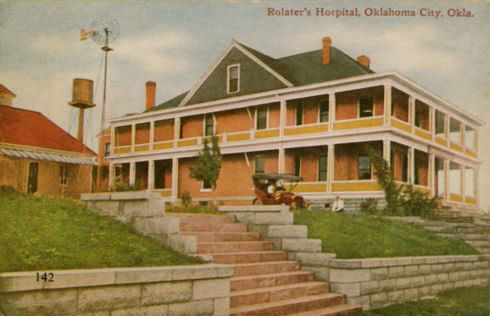
Wesley Hospital, 12th & Harvey (1911)
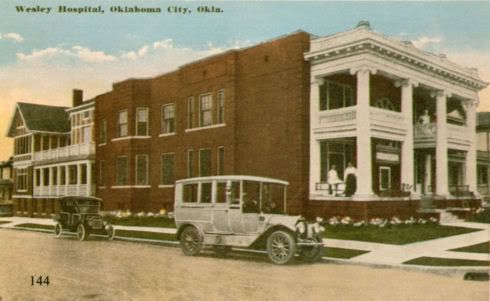
Credit Vanished Spendor III by Jim Edwards, Hal Ottaway & Mitchell Oliphant
(Abalache Book Shop Publishing Co. 1985)
The 1927 Wesley Hospital, 12th & Harvey
Became the Presbyterian Medical Center in 1964
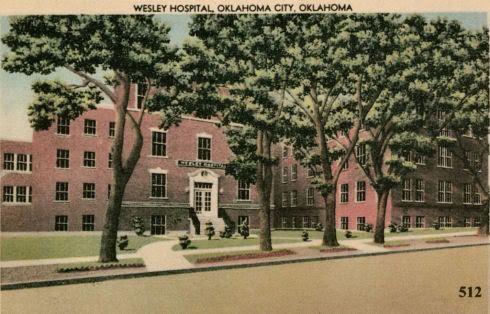
City Hospital, 401 NE 2nd, 1912, apparently intended for charity,
later called "Post-Graduate Hospital", later used by the Dept. of
Health for laboratory space, in the 1940s the Stiles Community Center

Credit Vanished Spendor II by Jim Edwards & Hal Ottaway
(Abalache Book Shop Publishing Co. 1983)
Originally the State Baptist Hospital (1916), it
became Oklahoma General Hospital in 1922, Mercy
Hospital in 1947. Before Mercy moved in 1974, it
occupied the block between Dewey & Walker, NW 13 & NW 12
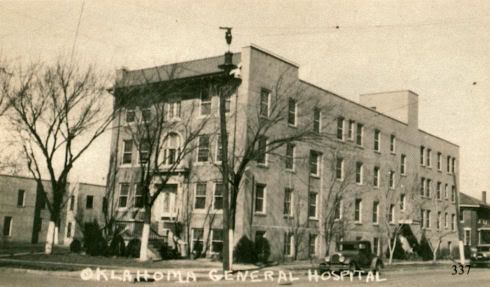
From My PostCard Collection
University Hospital on NE 13th (1919)
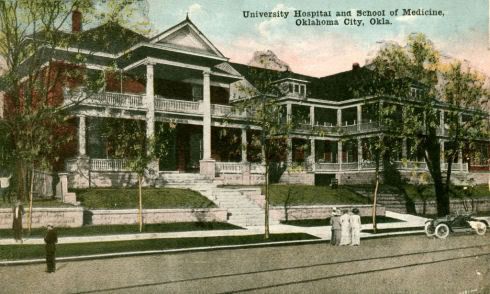
Polyclinic Hospital, NW Corner of 13th & Robinson (1929)
Later (?), the building was demolished and a newer facility
was built which has gone by various names, now Kindred Hospital
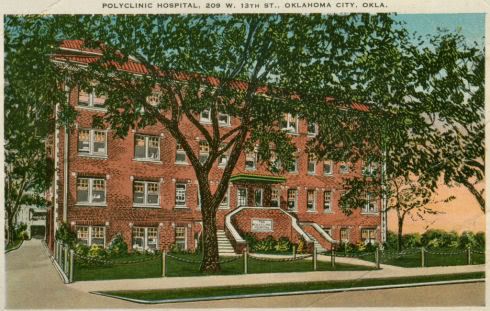
St. Ann Continues To Grow. St. Anthony's continued to grow over the years. The pic below is a rendering appearing in the March 16, 1958, Oklahoman showing then existing plans.
Click The Image For A Larger View
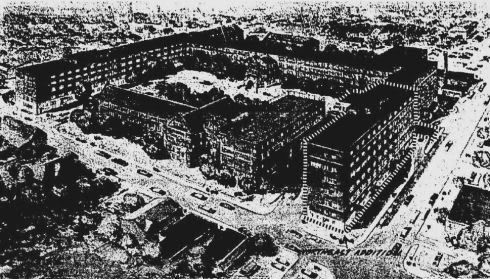
Not counting clinics (e.g., the McBride Clinic) and smaller hospitals (Kindred Hospital), St. Anthony's became the sole surviving major hospital in the city-center area. "Presbyterian" moved to NE 13th & Lincoln and is now part of the University of Oklahoma health care complex. Mercy moved to the far northwest on Memorial Road in 1974. Also moving or closing were many businesses, shops, etc., and the area around St. Anthony's became something less than desirable.
In 2002-early 2003, talk was that St. Anthony's might be moving also (I seem to recall that it might relocate to the north Moore area or something in that general vicinity which would not only remove the remaining major hospital from city-center but would leave yet another empty structure in the Midtown area, and a huge one at that.
But, that didn't happen. An August 1, 2003, Oklahoman article by Steve Lackmeyer reported a deal being offered to keep St. Anthony's downtown.
An October 25, 2003, Oklahoman article by Bryan Dean reported the good news:
Hospital staying downtown
St. Anthony Hospital and local government officials signed a deal Friday that could trigger more than $200 million of investment in the MidTown area and bring cutting edge cancer technology to the state.
The agreement to keep St. Anthony at its downtown location was signed less than four months after the hospital said it would either renovate its campus at NW 10 and Lee Avenue or move to another part of town.
"You cannot stress too much the importance of this day," County Commissioner Stan Inman said. "We have actually avoided a financial disaster for downtown Oklahoma City and this entire county, if not the whole state of Oklahoma."
The hospital’s main concerns were highway access, crime and blight in the area and a state Medicaid reimbursement formula that penalizes older hospitals.
Local officials have promised to correct neighborhood issues and will ask the state Transportation Department to help with highway access.
Steve Hunter, president and chief operating officer of SSM Healthcare, the hospital’s parent company, said he was surprised by the quick reaction of local officials.
"My expectation was that this thing was going to take forever," Hunter said. "To have this thing basically done in less than six months, I think shows a commitment by a lot of people."
State officials said they may have a solution to the Medicaid reimbursement issue.
Under the current formula, older hospitals tend to receive lower reimbursements because of a longer history with the Medicaid program, which is overseen locally by the Oklahoma Health Care Authority.
St. Anthony officials complained that the formula was discriminatory.
Nico Gomez, spokesman for the Oklahoma Health Care Authority, said a proposal before the authority’s board would raise all hospitals’ reimbursement rates to the state median before giving an across the board increase of 2 percent.
With most of its concerns addressed, the hospital plans to invest $200 million into its campus. City and county initiatives will improve the look of the area surrounding the hospital. The deal struck was obviously a community-wide deal ... the pic below (taken by Paul Hellstern of the Oklahoman shows the agreement's signators to be (left to right): Fred Hall, board chairmen of Downtown Oklahoma City, Inc.; Stanton Youg, chairman of the Urban Renewal Authority; Roy Williams, executive VP of the Okc Chamger of Commerce; Steve Hunger, president of St. Anthony Hospital; Stan Inman, Oklahoma County Commissioner; and Okc Mayor Kirk Humphreys.
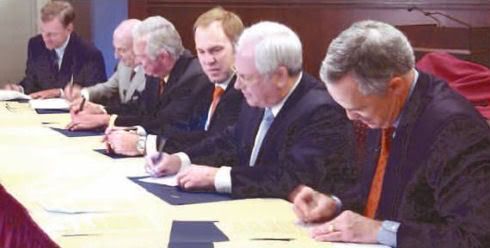
Midtown Resurgence. It certainly did no harm that Greg Banta became the primary mover and shaker in the Midtown area, together with the guy bankrolling many of the Banta Group's Midtown projects. Largely, that's another story for another day.
But it certainly does no harm that the Banta Group is restoring the historic Plaza Court, Oklahoma City's first shopping center, immediately northeast of the hospital's plaza. The images below were taken on July 20, 2007. Click any pic for a larger view.
Looking Northeast From Walker & NW 10th

Looking Southwest From Walker & NW 10th

The historic Kaiser's is now the Grateful Bean owned by Peter Schaeffer. It closed for a time in October 2004 because of construction of the traffic circle (aka "roundabout") ... but it did reopen. The building is more than 90 years old, and for decades was home to Kaisers Ice Cream. Schaffer bought the building in 1992, remodeled it, and got it listed on the National Register of Historic Places. He turned the landmark into a nonprofit restaurant that hired people who were either marginally employed or chronically unemployed. Though he feared it might not reopen, as you can plainly see, it did! Good for St. Anthony's, Peter's project, and for all of us.
Around NW 9th Looking West At New Construction
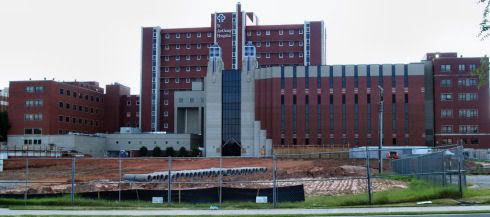
A Closer View
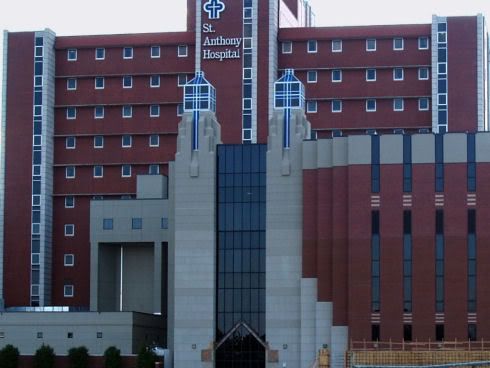
A Parking Garage on the South Side
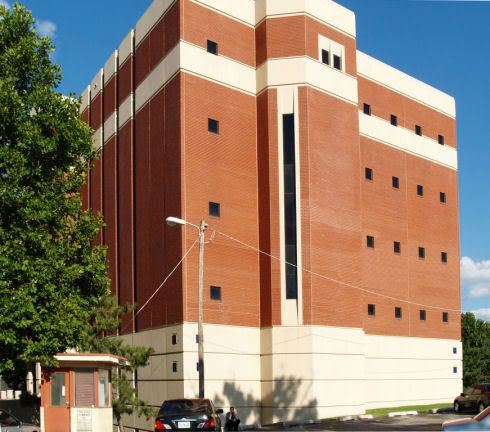
On the West Side Looking Southeast

And, Of Course, St. Francis Himself,
Patron Saint of the Religious Order
That Started St. Anthony's in 1898
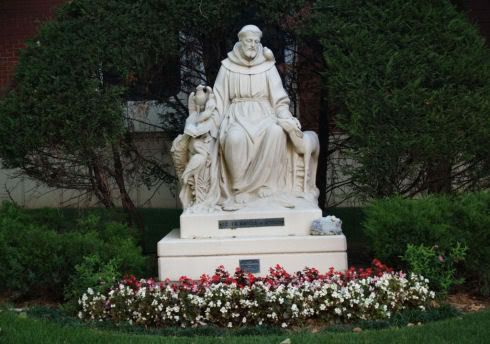
Today, St. Anthony's is reported to be Oklahoma City's largest hospital. I'm glad that I live nearby!
Go To Top
... Click here to read the full article and any comments ...
|






 The Tin Drum Affair. During the Downtown Library's tenure at NW 3rd (McGee) and Robinson, one of the city's most embarrassing moments involved what I'll call, "The Tin Drum Affair." A foreboding omen appeared in a November 12, 1980, Oklahoman article which reported that the director of the American Library Association's Office for Intellectual Freedom opined that America's public libraries "are facing a massive new wave of censorship in the wake of last week's conservative election victories." Locally, a February 23, 1966, Oklahoman article reported that the latest "extension" of book banning at Northwest Classen High School by Principal J. Frank Malone included Shakespeare's Romeo and Juliet and Nathaniel Hawthorne's The Scarlet Letter. Already on the banned list was J.D. Salinger's Catcher in the Rye. The article reported an unhappy mom as saying, "Now he's banning Shakespeare ... what's next?"
The Tin Drum Affair. During the Downtown Library's tenure at NW 3rd (McGee) and Robinson, one of the city's most embarrassing moments involved what I'll call, "The Tin Drum Affair." A foreboding omen appeared in a November 12, 1980, Oklahoman article which reported that the director of the American Library Association's Office for Intellectual Freedom opined that America's public libraries "are facing a massive new wave of censorship in the wake of last week's conservative election victories." Locally, a February 23, 1966, Oklahoman article reported that the latest "extension" of book banning at Northwest Classen High School by Principal J. Frank Malone included Shakespeare's Romeo and Juliet and Nathaniel Hawthorne's The Scarlet Letter. Already on the banned list was J.D. Salinger's Catcher in the Rye. The article reported an unhappy mom as saying, "Now he's banning Shakespeare ... what's next?"






































































